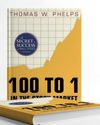試す 金 - 無料
DIG DEEPER
Beyond Market
|April, 2024
Investors chasing high-growth should prioritize near-term EPS explosion to justify high PE ratios, but also verify long-term business health and management before taking the plunge
-

In the dynamic world of financial markets, investors grapple with various factors when assessing a stock's attractiveness. Two pivotal elements that significantly sway stock valuations, or the price of a given stock, are the quantum of growth in earnings per share (EPS) and the quality of the underlying business.
This difference in valuation can be head-scratching. Why do some stocks trade at 40, 50, or even 70 times their earnings, whereas others stay stuck at 8 to 12 times earnings?
If you can figure this out, you might be able to identify those high PE stocks that are poised for "re-rating" - an upward adjustment in their PE ratio and become multi-baggers (stocks that experience significant growth) well before the crowd catches on.
The reason? Because if everything else remains the same, a ₹ 100 stock trading at 10 times its earnings would be worth ₹ 500 if valued at 50 times its earnings. This simple PE expansion translates to a whopping 500% return.
So, how is such a dramatic increase possible? This article dives into the nuances of these factors and aims to solve the equation for achieving a better PE ratio, which can lead to significant stock price appreciation.
First and foremost, there are two important factors that help companies or stocks improve their PE ratio.
• Growth In Earnings (EPS)
• Quality Of The Business
Let us first understand the growth in earnings or EPS:
Quantum Of Growth
Let's delve deeper into the first factor that grants companies a higher PE ratio, that is, the quantum of growth in earnings per share (EPS). Understanding this growth is paramount in evaluating a stock's potential.
このストーリーは、Beyond Market の April, 2024 版からのものです。
Magzter GOLD を購読すると、厳選された何千ものプレミアム記事や、9,500 以上の雑誌や新聞にアクセスできます。
すでに購読者ですか? サインイン
Beyond Market からのその他のストーリー

Beyond Market
THE TIPPING POINT
The Supreme Court's C verdict quashing BPSL sale to JSW Steel exposes glaring gaps, but proposed reforms show government's attempts at a reboot
6 mins
June, 2025

Beyond Market
A SURPRISINGLY BOLD MOVE
In a game-changing move, the MPC slashed the repo rate by 50 bps to boost consumption and investment, giving a fresh push to GDP growth
4 mins
June, 2025

Beyond Market
THE PUSH AND PULL OF INDIA'S ECONOMIC RISE
Led by reform, demographics, and digital ambition, India edges towards global prominence - challenged by the need for inclusive, sustainable growth
4 mins
June, 2025
Beyond Market
TECHNICAL OUTLOOK
On the weekly chart, Nifty exhibits a strong recovery from a prior downtrend. Currently, the index is trending within a rising channel, indicating sustained upward momentum.
2 mins
June, 2025

Beyond Market
MIRRORING THE MARKET
Index funds are a smart, low-cost way to ride the market without the guesswork
6 mins
June, 2025
Beyond Market
IMPORTANT JARGON
GOVERNMENT CUTS IMPORT DUTY ON CRUDE EDIBLE OIL
4 mins
June, 2025

Beyond Market
UNEARTHING CENTURIONS
Spot the one, stay the course — let time turn pennies into fortunes, says Thomas Phelps
9 mins
June, 2025

Beyond Market
LIGHTS, CAMERA, YOUTUBE
YouTube might be the new stage for films, but without deep pockets and star power, most producers may struggle to find their spotlight
5 mins
June, 2025

Beyond Market
THE BIG MOO-VE
The dairy industry is reinventing itself - milking consumer cravings and tech waves for richer returns
4 mins
June, 2025

Beyond Market
MAKING SUSTAINABILITY ACCOUNTABLE
In a decisive move that signals India’s commitment to environmental, social, and governance (ESG) values, the Securities and Exchange Board of India (SEBI) mandated the Business Responsibility and Sustainability Reporting (BRSR) framework for the top 1,000 listed companies starting FY23.
5 mins
June, 2025
